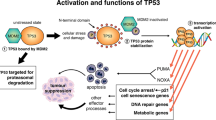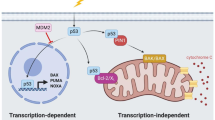Abstract
Protein p21Cip1/Waf1 is transcriptionally activated by the tumour suppressor p53 and previous studies have shown that p21 plays a role in tumour suppression. However, the involvement of p21 in p53-mediated tumour suppression remains to be directly demonstrated in vivo. Tumour suppression mediated by p53 can be measured by comparing tumour susceptibility in animals carrying two (wild-type mice) or three (super-p53 mice) copies of the p53 gene. We have taken advantage of this genetically defined system to measure p53-mediated cell-cycle arrest, apoptosis and tumorigenesis, in a p21 wild-type and in a p21-null context. The absence of p21 significantly impaired the enhanced p53-mediated cell-cycle arrest characteristic of super-p53 cells, but did not affect the enhanced apoptosis. Importantly, in an experimental model of fibrosarcoma induction, the absence of p21 significantly decreased the tumour suppression benefit of super-p53 mice. We conclude that cell-cycle arrest through p21 plays a significant role in mediating p53-dependent cancer protection.
This is a preview of subscription content, access via your institution
Access options
Subscribe to this journal
Receive 50 print issues and online access
$259.00 per year
only $5.18 per issue
Buy this article
- Purchase on Springer Link
- Instant access to full article PDF
Prices may be subject to local taxes which are calculated during checkout



Similar content being viewed by others
References
Adnane J, Jackson RJ, Nicosia SV, Cantor AB, Pledger WJ, Sebti SM . (2000). Loss of p21WAF1/CIP1 accelerates ras oncogenesis in a transgenic/knockout mammary cancer model. Oncogene 19: 5338–5347.
Bearss DJ, Lee RJ, Troyer DA, Pestell RG, Windle JJ . (2002). Differential effects of p21(WAF1/CIP1) deficiency on MMTV-ras and MMTV-myc mammary tumor properties. Cancer Res 62: 2077–2084.
Bissonnette N, Hunting DJ . (1998). p21-induced cycle arrest in G1 protects cells from apoptosis induced by UV-irradiation or RNA polymerase II blockage. Oncogene 16: 3461–3469.
Brugarolas J, Bronson RT, Jacks T . (1998). p21 is a critical CDK2 regulator essential for proliferation control in Rb-deficient cells. J Cell Biol 141: 503–514.
Brugarolas J, Chandrasekaran C, Gordon JI, Beach D, Jacks T, Hannon GJ . (1995). Radiation-induced cell cycle arrest compromised by p21 deficiency. Nature 377: 552–557.
De la Cueva E, Garcia-Cao I, Herranz M, Lopez P, Garcia-Palencia P, Flores JM et al. (2006). Tumorigenic activity of p21(Waf1/Cip1) in thymic lymphoma. Oncogene 6: 4128–4132.
Deng C, Zhang P, Harper JW, Elledge SJ, Leder P . (1995). Mice lacking p21CIP1/WAF1 undergo normal development, but are defective in G1 checkpoint control. Cell 82: 675–684.
el-Deiry WS, Tokino T, Velculescu VE, Levy DB, Parsons R, Trent JM et al. (1993). WAF1, a potential mediator of p53 tumor suppression. Cell 75: 817–825.
Fan S, Chang JK, Smith ML, Duba D, Fornace Jr AJ, O'Connor PM . (1997). Cells lacking CIP1/WAF1 genes exhibit preferential sensitivity to cisplatin and nitrogen mustard. Oncogene 14: 2127–2136.
Fotedar R, Bendjennat M, Fotedar A . (2004). Role of p21 (WAF1) in the cellular response to UV. Cell Cycle 3: 134–137.
Franklin DS, Godfrey VL, O'Brien DA, Deng C, Xiong Y . (2000). Functional collaboration between different cyclin-dependent kinase inhibitors suppresses tumor growth with distinct tissue specificity. Mol Cell Biol 20: 6147–6158.
Garcia-Cao I, Garcia-Cao M, Martin-Caballero J, Criado LM, Klatt P, Flores JM et al. (2002). ‘Super p53’ mice exhibit enhanced DNA damage response, are tumor resistant and age normally. EMBO J 21: 6225–6235.
Harper JW, Adami GR, Wei N, Keyomarsi K, Elledge SJ . (1993). The p21 Cdk-interacting protein Cip1 is a potent inhibitor of G1 cyclin-dependent kinases. Cell 75: 805–816.
Jackson RJ, Adnane J, Coppola D, Cantor A, Sebti SM, Pledger WJ . (2002). Loss of the cell cycle inhibitors p21(Cip1) and p27(Kip1) enhances tumorigenesis in knockout mouse models. Oncogene 21: 8486–8497.
Jackson RJ, Engelman RW, Coppola D, Cantor AB, Wharton W, Pledger WJ . (2003). p21Cip1 nullizygosity increases tumor metastasis in irradiated mice. Cancer Res 63: 3021–3025.
Komarova EA, Kondratov RV, Wang K, Christov K, Golovkina TV, Goldblum JR et al. (2004). Dual effect of p53 on radiation sensitivity in vivo: p53 promotes hematopoietic injury, but protects from gastro-intestinal syndrome in mice. Oncogene 23: 3265–3271.
Lowe SW, Ruley HE . (1993). Stabilization of the p53 tumor suppressor is induced by adenovirus 5 E1A and accompanies apoptosis. Genes Dev 7: 535–545.
Lowe SW, Schmitt EM, Smith SW, Osborne BA, Jacks T . (1993). p53 is required for radiation-induced apoptosis in mouse thymocytes. Nature 362: 847–849.
Martin-Caballero J, Flores JM, Garcia-Palencia P, Collado M, Serrano M . (2004). Different cooperating effect of p21 or p27 deficiency in combination with INK4a/ARF deletion in mice. Oncogene 23: 8231–8237.
Martin-Caballero J, Flores JM, Garcia-Palencia P, Serrano M . (2001). Tumor susceptibility of p21(Waf1/Cip1)-deficient mice. Cancer Res 61: 6234–6238.
Palmero I, Serrano M . (2001). Induction of senescence by oncogenic ras. Methods Enzymol 333: 247–256.
Philipp J, Vo K, Gurley KE, Seidel K, Kemp CJ . (1999). Tumor suppression by p27Kip1 and p21Cip1 during chemically induced skin carcinogenesis. Oncogene 18: 4689–4698.
Poole AJ, Heap D, Carroll RE, Tyner AL . (2004). Tumor suppressor functions for the Cdk inhibitor p21 in the mouse colon. Oncogene 23: 8128–8134.
Samuel T, Weber HO, Funk JO . (2002). Linking DNA damage to cell cycle checkpoints. Cell Cycle 1: 162–168.
Strathdee G, Sansom OJ, Sim A, Clarke AR, Brown R . (2001). A role for mismatch repair in control of DNA ploidy following DNA damage. Oncogene 20: 1923–1927.
Topley GI, Okuyama R, Gonzales JG, Conti C, Dotto GP . (1999). p21(WAF1/Cip1) functions as a suppressor of malignant skin tumor formation and a determinant of keratinocyte stem-cell potential. Proc Natl Acad Sci USA 96: 9089–9094.
Vousden KH, Lu X . (2002). Live or let die: the cell's response to p53. Nat Rev Cancer 2: 594–604.
Vousden KH, Prives C . (2005). P53 and prognosis: new insights and further complexity. Cell 120: 7–10.
Weinberg WC, Fernandez-Salas E, Morgan DL, Shalizi A, Mirosh E, Stanulis E et al. (1999). Genetic deletion of p21WAF1 enhances papilloma formation but not malignant conversion in experimental mouse skin carcinogenesis. Cancer Res 59: 2050–2054.
Xiong Y, Hannon GJ, Zhang H, Casso D, Kobayashi R, Beach D . (1993). p21 is a universal inhibitor of cyclin kinases. Nature 366: 701–704.
Yang W, Velcich A, Lozonschi I, Liang J, Nicholas C, Zhuang M et al. (2005). Inactivation of p21WAF1/cip1 enhances intestinal tumor formation in Muc2-/- mice. Am J Pathol 166: 1239–1246.
Yang WC, Mathew J, Velcich A, Edelmann W, Kucherlapati R, Lipkin M et al. (2001). Targeted inactivation of the p21(WAF1/cip1) gene enhances Apc-initiated tumor formation and the tumor-promoting activity of a Western-style high-risk diet by altering cell maturation in the intestinal mucosal. Cancer Res 61: 565–569.
Acknowledgements
We are indebted to Maribel Muñoz for excellent mouse colony management and animal care, and to Elisa Santos for mouse genotyping. AE is funded by a predoctoral fellowship from the Spanish Ministry of Education and Science (MEC). SV-M is funded by the Ramon y Cajal Program of the MEC. Work at the laboratory of MS has been funded by the CNIO, the MEC (SAF2005-03018) and by the European Union (INTACT, PROTEOMAGE).
Author information
Authors and Affiliations
Corresponding author
Rights and permissions
About this article
Cite this article
Efeyan, A., Collado, M., Velasco-Miguel, S. et al. Genetic dissection of the role of p21Cip1/Waf1 in p53-mediated tumour suppression. Oncogene 26, 1645–1649 (2007). https://doi.org/10.1038/sj.onc.1209972
Received:
Revised:
Accepted:
Published:
Issue Date:
DOI: https://doi.org/10.1038/sj.onc.1209972
Keywords
This article is cited by
-
Unveiling how vitrification affects the porcine blastocyst: clues from a transcriptomic study
Journal of Animal Science and Biotechnology (2022)
-
Limited survival and impaired hepatic fasting metabolism in mice with constitutive Rag GTPase signaling
Nature Communications (2021)
-
Ubiquitin-conjugating enzyme E2T (UBE2T) and denticleless protein homolog (DTL) are linked to poor outcome in breast and lung cancers
Scientific Reports (2017)
-
Endoplasmic reticulum stress sensitizes cells to DNA damage-induced apoptosis through p53-dependent suppression of p21CDKN1A
Nature Communications (2014)
-
FATS is a transcriptional target of p53 and associated with antitumor activity
Molecular Cancer (2010)



